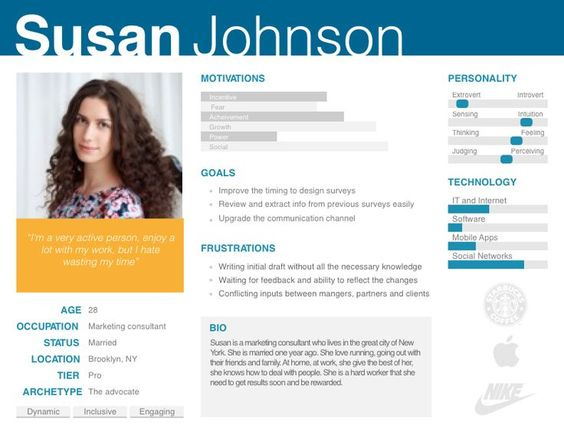A 7-Step guide for creating personas
Here’s a practical 7-step guide for creating personas:
1. Get other departments involved
Don’t create your personas in a vacuum. Creating in a vacuum means you’ll be creating personas only relevant to you. Get the heads of all the customer-facing teams involved in the process. This way, it’s easier to get teams at the company to use the personas after they’re created. Find out who you need to be in the room and bring them together for a brainstorming session. This helps with getting the team to adopt the personas and use them later on.
2. Work backwards
Determine what you want to achieve in the persona interviews. Brainstorm with stakeholders on what information will be useful in your personas and how people will use this information in certain scenarios. You’ll have a limited quantity of space for information so asking how people will use the information will help to keep the information concise and relevant.
3. Determine what will and will not be included in your personas.
Next, use your product marketing lens to determine what will and will not be included in your personas after the brainstorming session. But remember, just because the answer to a question will not be included in your personas doesn’t mean you shouldn’t ask the question. If it’s an important question there’ll always be use for the information so ask the question and find other ways to store your findings
4. Find out what questions will get you the answers you need
After you’ve determined the information you need, figure out the questions you’ll need to ask to get you this information. Follow each question asked with a ‘Why?’. ‘Why’ gets you closer to your customers’ motivators and helps you understand them better.
If you’re unsure about what questions to ask you can use a curated user persona question list like this one from Product Marketing Alliance.
5. Start speaking to customers
Now you’re done with the prep work, it’s time to start speaking to your customers! Speak to both prospects and customers on the phone or in person. You can use quantitative research methods to gather information e.g. forms but always start with speaking to customers.
Be sure to record the conversation- let the interviewee know you’ll be recording the conversation before the interview starts.
Other tips:
Make it clear the call won’t be sales related
Speak to both prospects and customers. Don’t neglect prospects because they’re harder to secure- they’re more likely to be unbiased. Speak to people who haven’t heard of you at all.
Go after both good and bad customers for a balanced view
Ask questions that are centred on emotions like, “What frustrates you the most?”, “What do you dislike most about…”.
Questions like “Tell me about your last purchase” are also great because events that have already happened provide more information than hypothetical scenarios.
Get referrals. After every interview, ask if they know anyone else that fits your target audience who wouldn’t mind getting interviewed too.
How many customers/prospects should you speak to? No hard rule but aim for at least 5 - 10 matching patterns.
Use a transcription tool like otter.ai to transcribe the interview and then run through the transcribed interviews in a word counter tool so you can see what words interviewees used the most.
After your persona research interviews, here’s how you can continue to top up your knowledge base
Add a couple of fields to your website forms
Include relevant questions as part of your onboarding process
Get sales and customer success to ask questions before, during and after their conversations with customers
6. Consolidate information
Before interviews, ensure you have a process or method for gathering and keeping the data you’ll get. A spreadsheet may be very useful in this instance.
7. Create your persona template
I would recommend having 2 sets of persona templates. One with all the information you need - the classic type that looks like this:
and one set that has only the essential keywords that can be used when people just need a quick refresher. Sort of like these ones created by Mailchimp.
Information packed persona templates may be boring so create a set of templates with just enough information or keywords for colleagues and people at the organisation to use in their day to day jobs.
Here are some tools you can use to create your persona templates:
You can also check out more awesome tools here.
How to use AI for your persona research
For my last magic trick, I’ll be showing you how to use Crystal AI and LinkedIn for persona research at B2B companies:
- Create a list of job titles at companies that match your target market
- Install the Crystal AI plugin on your Chrome browser
- Search for people with job titles at companies that fit your target market
- Click the crystal icon that shows up on the right side of your screen
This will give you a breakdown of information like their personality types, drivers and motivations, how to approach sales calls, meetings and emails.
Repeat this till you see a pattern (I'd recommend approximately 10 - 30 profiles. The free trial lets you view up to 10 profiles) and then document the common traits.
You can send me a message on my LinkedIn if you end up trying this.




